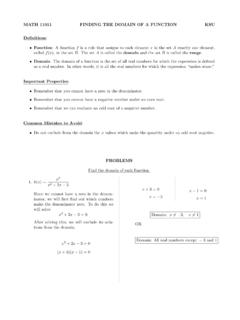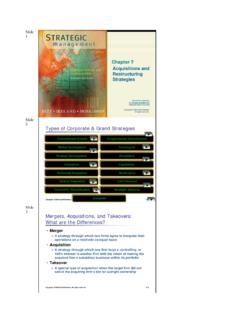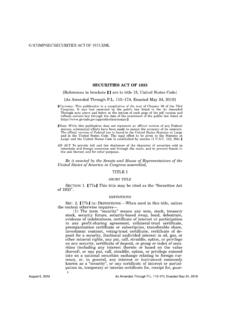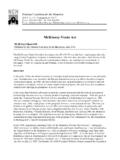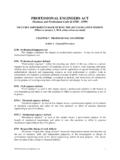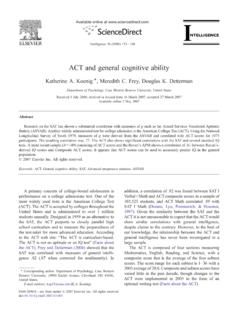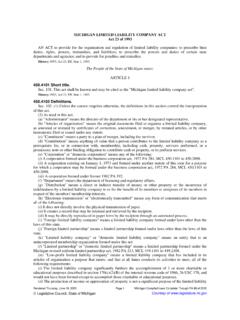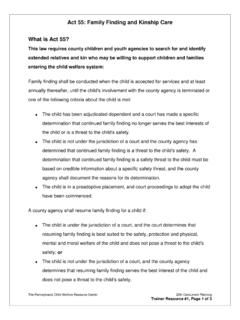Transcription of Acceptance and Commitment Therapy - Kent State University
1 1 Acceptance andCommitment TherapySteven C. Hayes Kirk D. StrosahlKelly G. s an old joke ..Overview of ACT To explain the ACT theoretical model To layout the general clinical approach To give examples of the techniques,including some you can useregardless of orientation To encourage you to explore the area2 Pain and Pathology Dania, Fla. June 16 (AP) A 6-yearold girl was killed today when shestepped in front of a train, tellingsiblings that she wanted to be with hermother. The authorities said that hermother had a terminal York Times, June 17, 1993 The Assumption ofHealthy Normality By their nature humans arepsychologically healthy Abnormality is a disease or syndromedriven by unusual pathologicalprocesses We need to understand theseprocesses and change themThe Ubiquity ofHuman Suffering High lifetime incidence of major DSMdisorders High treatment demand from otherpersons High rates of divorce, sexual concerns,abuse, violence, prejudice, loneliness Some extremely destructive behaviors areboth common and non-syndromal, ,suicide3 Alternative Assumption:Destructive Normality Normal psychological processes oftenare destructive We need to understand theseprocesses and work within them topromote health Ancient nominee.
2 Human languageand cognition ( , the Genesis story)Experiential Avoidance The tendency to attempt to alter the form,frequency, or situational sensitivity ofhistorically produced negative privateexperience (emotions, thoughts, bodilysensations) even when attempts to do socause psychological and behavioral harm Is built into human language Is embedded in culture, science, andtechnologyPeople tell meit s a sin toknow and tofeel too muchwithin ..Bob DylanExperiential Avoidance4 Experiential Avoidance is ..Lonelinessand miseryand sufferingandunhappinessThat weattempt toavoid,dampen,suppress,defendagainst, name it,we do it!!How We Make Things Worse Without the ability to open up todiscomfort without suppression, it issimply not possible to face difficultproblems in a healthy way Experiential avoidance increases theimpact and often even the frequencyof avoided thoughts, feelings, andsensationsHigher Experiential Avoidance.
3 Is associated with: Higher anxiety More depression More overall pathology Poorer workperformance Inability to learn Substance abuse Lower quality of life History of sexual abuse High risk sexual behavior BPD symptomatologyand depression Thought suppression Alexithymia Anxiety sensitivity Long term disabilitySources: Hayes et al (in press); Polusny (1997); Toarmino (1998); Pistorello (1997); Batten, Follette, & Aban (1998);Stewart, Zvolensky, & Eifert (1998);5 Yet it Seems to be Built intoMainstream Assumptions Names of disorders Names of techniques Measures ModelsA Simpler Version of theBarriers that ACT TargetsFEAR: Fusion Evaluation Avoidance, and ReasonsCognitive Fusion Excessive attachment to a thoughtthat does not allow us to be in thepresent moment Living in the past or the future Constructing a world for ourselvesdominated by literal language Excessive labeling of ourexperiences6 Experiential avoidance andCognitive Fusion are basic We live in a verbal world about something,somewhere else, some time else The chatter in our heads gets very dominant There is no place a human can go that is painfree As much as we wish it were so, we cannotregulate pain by regulating the situation So we do, in self-defense, experientialavoidance.
4 Even though it does not ultimatelyworkFive Components of the current situation Creative as as a ChoiceGeneral ACT Inherent paradox Verbal confusion and sensible incoherence Creation of healthy Point to the problem or encourage solutions withoutdirectly instructing exercises contact with raw experiential material in a safe functional Commitment and change exercise7 Creative Hopelessness: Acceptance of Where You Start You ve tried about everything Suppose your experience is valid?Suppose it won t work Metaphors Man in the hole Upset / Struggle / Workability Don t believe a word I m sayingDon t believe a word I am sayingDon t believe a word I am saying A core element of ACT is in getting clients toexperience their own emotions as purely andauthentically as possible The role of the therapist is not to provide his orher way of doing it, but rather to provideguidance so that the client can do it for himself orherself The phrase Don t believe a word I am saying, is often used in ACT so that the client is nottempted to simply adopt the therapist s position,but instead to lean into the experience asauthentically as possible8 Cognitive Defusion De-Fusion Present contexts that reduce theliteral and evaluative functions oflanguage and cognition.
5 Reduce the domination of problematicinterpretations that previously werebased on category, time, andevaluationCognitive DefusionDefusion Exercises Thank your mind for that thought There are four of us in the roomright now, you, me, your mind andmy mind Titchener s ExerciseTitchener s ExerciseGot Milk?9 ACT MetaphorsAcceptance Encourage direct moment-to-momentcontact with previously avoided privateevents (that functionally need not beavoided) as they are directly experiencedto be If control is the problem, why does itpersist? If you are not willing to have it, you will Substitute just about any word for it , your depression, your anxiety, etcAcceptance InterventionsMetaphors Gun at the head Tug of war with a monster Quicksand Feed the tiger Train on tracks Remember three numbers Chinese Handcuffs10 ACT MetaphorsACT MetaphorsACT Metaphors11 Self as Context Spirituality and transcendence ashuman experiences Making contact with that sense ofself that is safe and consistentperspective on the world and thuspromote present moment focusContact with thePresent Moment Mindfulness exercises begin eachsession Leaves on the stream Relationship focus moment to moment During exposure.
6 Focus on the momentChoice and Values Helping the patient clarify the values theshe or he holds Helping the patient get motivated fortreatment Helping the patient reorient her/his life fromavoidance to approach of valued goalsExercises Declaration Tombstone What matters12A Simpler Version ofthe Goals of ACTACT Accept Choose Take actionACT Said Simply ACT uses Acceptance andmindfulness processes, andcommitment and behaviorchange processes, to producegreater psychological flexibilityPsychological Flexibility Psychological flexibility is acontinuous process of contacting thepresent moment fully (withoutdefense; as it is) as a conscious,human being, and based on what thesituation affords changing orpersisting in behavior in the serviceof chosen values13 The ACT Question Given a distinction between you andthe things you are struggling with andtrying to change, are you willing toexperience those things, fully andwithout defense, as it is and not as itsays it is, and do what works for youin this time and situation?
7 The goal is toFEEL good notto feel ExercisesThe Mountain MeditationDoing modeBeing mode15 Eye to Eye Sit in pairs, knees betweenknees Look at the other person Notice the chatter Let go and be present tobeing with another personLeaves in a Stream Imagine that there are leaves floating in a stream belowyou. You are sitting under a tree on a hill a few feet awayon a warm day watching the leaves float by. As each leafgoes by, allow it to have a thought or image of a thoughton it, whichever applies for you. One thought is on eachleaf. I want you to simply watch the leaves go by in thestream, without having to stop them or jumping in thestream with them. You are just to let them flow. This willprobably be hard not to interrupt, and that is you catch yourself interrupting the flow when youare in the stream or have lost the exercise -- see if youcan back up and see what you were doing just beforethat.
8 Then go back to the tree and let the leaves float byonce Your Mind for a Walk Groups of two: One is a person, one is amind. Person goes where he/she chooses; Mindsmust follow. Persons: this is your job Go wherever you choose to go See, hear, smell, feel note what is happeningaround you and in you. Feel your feet, leg,torso, hands as you walk. Notice things younormally would not. And gently, compassionately listen to your : this is your job .. Get close to your person and communicate nearlyconstantly: describe, analyze, encourage, evaluate,compare, predict, summarize, warn, cajole, evaluate,and so on. Persons cannot communicate with his or her mind. Themind must monitor this, and stop the person ("Nevermind your mind") if the rule is violated. Persons should listen to their minds without mindingback and go where you choose to go.
9 After five minutes, persons become minds and mindsbecome persons (minds watch the time). When each has had a turn, split up and walk quietly byyourself for five minutes. While you are walking, walk mindfully .. and notice thatyou are still taking your mind for a walk. Personsshould follow the same as before rules during this Timeout pair up mindful about client Job 1: express concern about a client don't be a clinician don t try to explain be a concerned person Job 2: listener appreciate don't be a clinician don t nod, smile, hand pat don t try to understand (see & appreciate a sunset) Switch Job 3: Eyes on appreciate no talking


